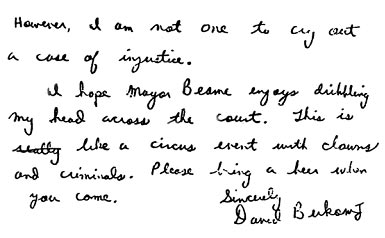List of 12 Handwriting Characteristics
Handwriting Analysis characteristics
The 12 Handwriting characteristics is very important to forensic scientist students because it helps to examine forgery in checks and other forgery of notes in a crime. Everybody has a unique personality in their handwriting because of spontaneous interactions between someone’s brain, eyes and hands. Handwriting can change by that physical or emotion state that person might be going through. As a person gets older, their handwriting gets distinctions. These are the 12 different handwriting analysis characteristics. The first handwriting characteristic is line quality, which means that the handwriting could have been shaky or might have free smooth flow of words. The second handwriting characteristic is called the spacing of words and letters. This handwriting characteristic means that letters in the handwriting might have consistent spaces or no spaces between the letters of the words. The third handwriting characteristic is called the examination of ratio of height, width, and size of letters.
This handwriting characteristic means that the letters in a word could start with tall large letters then end with short thick letters. It matters how the letter of the words balance out. The fourth examination technique is pen lifting which means the writer may start writing a word from a note then stop in the middle of the word and then start all over again. The pen lifting technique is very important to examine because it can usually mean forgery is taking place. The fifth examination is the connecting strokes this means that the capital letters may be connected to the lower case letters. The sixth examination is called the beginning and ending strokes, which means the letters may have curls, loops and may have a upward or downward stroke. The seventh examination is called Unusual letter formation this means letters could form letters with backward letters and unusual attributes on letters of words. I often myself do that in a lot of my handwritten notes. I have tried to stop that particular technique but it always tends become a habit after while. I guess my mind starts always cursive letters and then starts with normal print handwriting. I guess in my fifth and sixth grade year my mind gets mixed up on cursive lettering and that is why I have weird letter formations. The eighth examination is called pen pressure means that if the note might have upward and downward strokes all through the words. When tracing is taking place in a forgery of a note or check pen pressure is sometimes applied during tracing. The ninth handwriting characteristic is slant letters which means there could be letters that are slant from the right or the left side. The tenth handwriting characteristic is baseline habits. This means that letters in the word could be below the particular imaginary line or all on the same line. The eleventh handwriting characteristic is fancy writing habits. This handwriting characteristic means that the letters in the word could have extra trimmings or frills. The last handwriting analysis characteristic is diacritics. Diacritic means that writing is examined how the t’s are crossed and how the I’s are dotted. They could be to the left or the right of the letter. They also could have not crossed the t's and dotted the I’s.
This handwriting characteristic means that the letters in a word could start with tall large letters then end with short thick letters. It matters how the letter of the words balance out. The fourth examination technique is pen lifting which means the writer may start writing a word from a note then stop in the middle of the word and then start all over again. The pen lifting technique is very important to examine because it can usually mean forgery is taking place. The fifth examination is the connecting strokes this means that the capital letters may be connected to the lower case letters. The sixth examination is called the beginning and ending strokes, which means the letters may have curls, loops and may have a upward or downward stroke. The seventh examination is called Unusual letter formation this means letters could form letters with backward letters and unusual attributes on letters of words. I often myself do that in a lot of my handwritten notes. I have tried to stop that particular technique but it always tends become a habit after while. I guess my mind starts always cursive letters and then starts with normal print handwriting. I guess in my fifth and sixth grade year my mind gets mixed up on cursive lettering and that is why I have weird letter formations. The eighth examination is called pen pressure means that if the note might have upward and downward strokes all through the words. When tracing is taking place in a forgery of a note or check pen pressure is sometimes applied during tracing. The ninth handwriting characteristic is slant letters which means there could be letters that are slant from the right or the left side. The tenth handwriting characteristic is baseline habits. This means that letters in the word could be below the particular imaginary line or all on the same line. The eleventh handwriting characteristic is fancy writing habits. This handwriting characteristic means that the letters in the word could have extra trimmings or frills. The last handwriting analysis characteristic is diacritics. Diacritic means that writing is examined how the t’s are crossed and how the I’s are dotted. They could be to the left or the right of the letter. They also could have not crossed the t's and dotted the I’s.
"Handwriting Analysis Teacher Background Information." Forensic Investigations. Web. 4 Nov. 2011. <http://www.clt.uwa.edu.au/__data/page/112506/fsp10_handwriting.pdf>.
This website gets the credibility for idea about each handwriting analysis characteristic and their specific meaning.
Citations for pictures
Koren, Anna. "Handwriting Analysis - Cold Case Investigations." Cold Case Investigations - Powered by VBulletin. Web. 04 Dec. 2011. <http://officialcoldcaseinvestigations.com/showthread.php?t=509>.

No comments:
Post a Comment